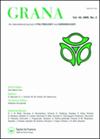Characterization of a glacial neotropical rainforest from pollen and spore assemblages (Colônia, São Paulo, Brazil)
IF 1
4区 生物学
Q4 PLANT SCIENCES
引用次数: 1
Abstract
Abstract A total of 115 palynomorphs recovered from samples collected in the Colônia basin were described. The morphological descriptions were accompanied by illustrations and ecological information. The palynomorphs date back to the penultimate glacial with ages ranging from 135 to 180 ka. The palynomorphs were grouped according to their presence in three forest types represented in the Colônia basin, namely hillside forest, peat forest and swamp forest. The 115 identified taxa represent a total 58 families; one represents the algae, and 57 Embryophyta (ten pteridophytes, two gymnosperms and 45 angiosperms); 52% of the palynomorphs were observed in the three local forest types. 32.4% were observed in other types of vegetation distributed within a radius of 5 to 15 km from the basin. These palynomorphs represent mature forest, secondary forest, cloud forest, grassland, and disturbed environment whereas 15.6% of the palynomorphs were no longer observed in the region of Colônia. The species represented by these palynomorphs most likely disappeared from the region of Colônia during interglacial climate warming. In addition, our study provides reference material for future pollen studies in Colônia since some vulnerable species were identified.冰川新热带雨林的花粉和孢子组合特征(Colônia, 圣保罗,巴西)
摘要本文报道了Colônia流域采集的115种形态生物。形态描述附有插图和生态信息。这些地貌可追溯到第二次冰期,年龄在135 ~ 180 ka之间。根据其在Colônia盆地所代表的3种森林类型(山腰森林、泥炭森林和沼泽森林)中的存在情况对其进行分组。经鉴定的115个分类群共58科;1种代表藻类,57种胚胎植物(10种蕨类植物,2种裸子植物和45种被子植物);在3种地方林型中观察到52%的异型。32.4%分布在距盆地5 ~ 15 km半径范围内的其他类型植被中。这些植被类型主要有成熟林、次生林、云雾林、草地和受干扰的环境,而在Colônia地区15.6%的植被类型已经消失。在间冰期气候变暖期间,以这些形态为代表的物种极有可能在Colônia地区消失。此外,本研究还发现了一些脆弱物种,为Colônia花粉研究提供了参考资料。
本文章由计算机程序翻译,如有差异,请以英文原文为准。
求助全文
约1分钟内获得全文
求助全文
来源期刊

Grana
生物-植物科学
CiteScore
2.10
自引率
11.10%
发文量
23
审稿时长
>12 weeks
期刊介绍:
Grana is an international journal of palynology and aerobiology. It is published under the auspices of the Scandinavian Palynological Collegium (CPS) in affiliation with the International Association for Aerobiology (IAA). Grana publishes original papers, mainly on ontogony (morphology, and ultrastructure of pollen grains and spores of Eucaryota and their importance for plant taxonomy, ecology, phytogeography, paleobotany, etc.) and aerobiology. All submitted manuscripts are subject to initial appraisal by the Editors, and, if found suitable for further consideration, to peer review by independent, anonymous expert referees. All peer review is single blind and submission is online via ScholarOne Manuscripts.
 求助内容:
求助内容: 应助结果提醒方式:
应助结果提醒方式:


